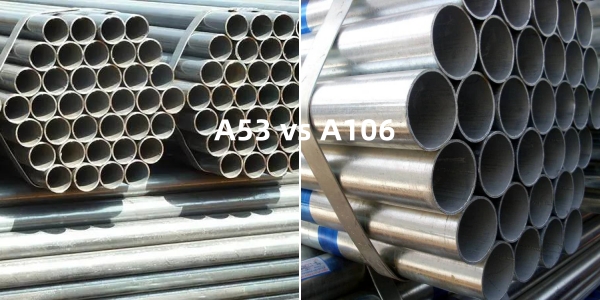ASTM A53 and ASTM A106 are both standards that cover seamless carbon steel pipe for high-temperature service. While they have some similarities, there are key differences between ASTM A53 and ASTM A106 steel pipes, primarily related to their intended applications, manufacturing processes, and chemical composition. In this article, Union Steel Industry will talk about some of the main differences between ASTM A53 and ASTM A106 steel pipes.

1. Application:
ASTM A53: Designed for general-purpose applications and is suitable for welding, bending, and flanging. It is commonly used for low-pressure plumbing and as structural steel in non-critical applications.
ASTM A106: Specifically designed for high-temperature services. It is intended for use in high-temperature and high-pressure applications such as process piping, power plants, and in the oil and gas industry.
2. Grade:
ASTM A53: There are three types - Type F (furnace-welded), Type E (electric resistance welded), and Type S (seamless). Grade A and Grade B are common for Type S.
ASTM A106: There are three grades - Grade A, Grade B, and Grade C. Grade B is the most commonly used grade and is widely used in applications where higher temperature resistance is required.
3. Manufacturing Process:
ASTM A53: Can be produced through either a seamless or welded process. The choice between seamless and welded depends on the application requirements.
ASTM A106: Generally produced only as a seamless product. The seamless manufacturing process ensures better wall thickness consistency and mechanical properties.
4. Chemical Composition:
ASTM A53: The chemical composition includes carbon, manganese, phosphorus, sulfur, copper, nickel, chromium, molybdenum, and vanadium. The maximum carbon content is 0.3% for Grade A and 0.35% for Grade B.
ASTM A106: The chemical composition is more stringent, with lower allowable levels of elements such as phosphorus and sulfur. It has specific limits for carbon and manganese content.
5. Testing and Inspection:
ASTM A53: Requires hydrostatic and nondestructive electric tests. The weld seam of electric-resistance welded pipe must be heat-treated after welding.
ASTM A106: Requires more extensive testing, including hydrostatic and nondestructive electric tests, flattening tests, and tensile tests. It also has stricter acceptance criteria.
6. Tolerances:
ASTM A53: Tolerances are not as stringent as those specified for ASTM A106 pipes.
ASTM A106: Specifies tighter tolerances, particularly in terms of wall thickness.
In summary, ASTM A53 and ASTM A106 are both widely used standards for seamless carbon steel pipes, but they cater to different applications and have variations in terms of grades, manufacturing processes, chemical composition, testing requirements, and tolerances. When selecting between them, it's essential to consider the specific requirements of your intended application.

 English
English Español
Español




 Tel : +86-18565811709
Tel : +86-18565811709 Email :
Email : 

 News
News




